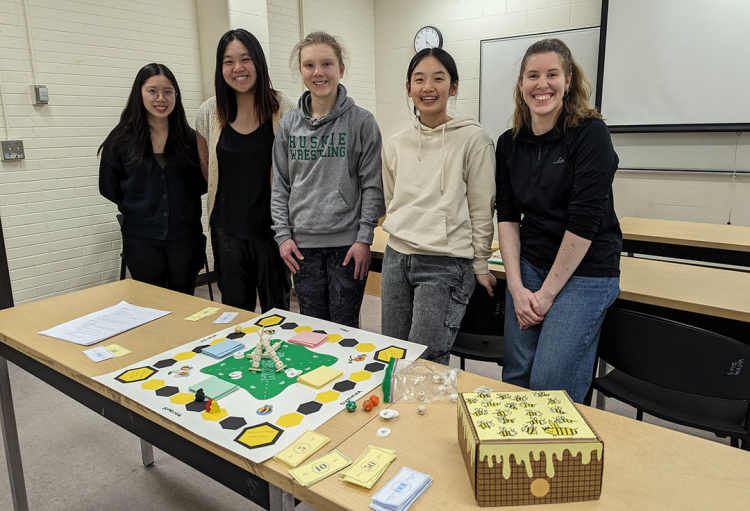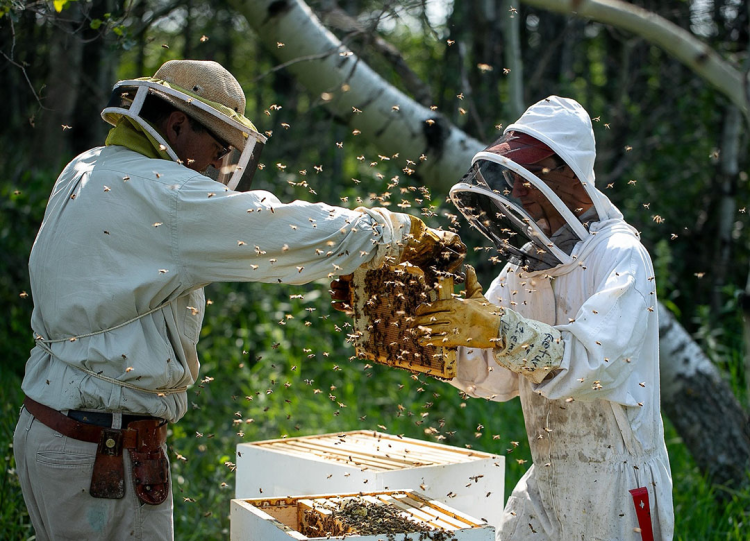As I made my way to the lecture theatre, a swarm of veterinary students spilled out through the doors, game boards tucked under their arms and dice clutched in their hands.
Down the hall and throughout the student commons area in the Western College of Veterinary Medicine (WCVM), clusters of students hunched over handmade board games, flipping chance cards and rolling dice. There was laughter, rule clarifications, and the occasional mention of queen pheromones and Varroa mites.
This was no ordinary university course it was pollinator science in action.
Honey Bee Diseases is a third-year elective course for veterinary students that's taught by Dr. Sarah Wood (DVM, PhD), an associate professor at the WCVM and the University of Saskatchewan's (USask) Pollinator Health Research Chair. The course's final assignment: create a bee health-themed board game that applies what students have learned throughout the term.

A group of third-year WCVM students demonstrate their honey bee health game. Left to right: Melissa Leon, Joyce Huang, Allison Kuzub, Joy Cui and Sarah Halldorson. (Photo: Rigel Smith)
The project might seem playful on the surface, but as I watched students strategize, debate bee biology, and rattle off facts about colony dynamics and viral disease vectors, it was clear: these students weren't just playing games. They were learning to think like pollinator researchers.
On May 20, people around the world will celebrate World Bee Day, recognizing the pollinators' essential contributions to global food security, biodiversity and ecosystem health. But honey bees are facing a variety of serious threats including climate variability, pesticide use, habitat loss and deadly parasites like Varroa destructor, a mite that weakens bees and spreads viruses throughout colonies.
"Bee health is becoming more complicated," said Geoff Wilson, provincial apiculturist with the Government of Saskatchewan. "We've been using chemical controls to manage mites since the 1990s, but we're now seeing resistance. It's getting harder to keep them under control, and that's leading to higher winter losses."
Wilson supports beekeepers across the province, helping them navigate challenges like colony collapse and emerging diseases. He also spends time in classrooms, connecting with students and supporting public education efforts.
"It's really always been about bee health and we definitely need veterinarians involved," he said. "Beekeeping uses antibiotics to manage bacterial infections, so veterinarians play a critical role. Even if [veterinary] students don't specialize in bee health, they need to understand it especially if they end up practising in rural areas where they might be the only veterinarian in town."
Tucked away in a side room, I found a group of students hovering around a table and walking classmates through the rules of their game. On the table sat a large, square game board decorated with black and yellow hexagonal tiles. It was dotted with player tokens, handmade playing cards and Monopoly-style bills. The four seasons spring, summer, fall and winter were written around the board's perimeter.
"It's a strategy game," said Sarah Halldorson, a third-year veterinary student who designed the game with her classmate, Joy Cui. The two had swapped games with another group of classmates and were explaining the rules.
"You start in the spring and move through the year together with your colony. Each move represents two weeks, and you can take actions to support your hive before a chance card comes up," Halldorson explained.
The chance cards reflected real-world seasonal challenges faced by beekeepers. The players' actions such as inspecting frames and talking to neighbouring farms about pesticide use helped strengthen their hives and improve the odds of survival.
"We kind of went overboard," said Halldorson. "We accidentally made the game too hard. We tried it out at lunch, and I lost my entire hive and so did they."
Now taking a turn as players, Halldorson and Cui opened the small cardboard box decorated with cartoon bees and oozing honey. Inside was a stack of bee health trivia cards made by their classmates.

Members of the WCVM's honey bee health research group work with bee hives at USask's Livestock and Forage Centre of Excellence. (Photo: Christina Weese)
In this speed game, a "beekeeper" held an answer key while two students went head-to-head answering trivia questions everything from the purpose of royal jelly to the average percentage of colony loss in winter. If players drew a "queen" card and answered three queen bee-related trivia questions correctly, they automatically won the game.
Somehow, I became the beekeeper. Students peppered me with rapid-fire guesses, debating the meaning of "trophallaxis" (exchange of food or fluids between insects) and the correct pronunciation of "spermatheca" (a sac for sperm storage in the female bee's reproductive tract).
Walking down the hall, I scouted out more game players. They weren't hard to find the common areas buzzed with activity.
A group of four students huddled around colourful game pieces, a handful of 20-sided dice and piles of resource cards that read "water" and "honey."
The group was in debate. One player wanted to trade in for a worker bee to add to her hive, but she didn't have a nurse bee to care for it. The others argued that the worker bee wouldn't survive and denied the trade.
This group had adapted the popular Settlers of Catan board game into a honey bee-themed world where players collected resources to build hives and avoid environmental setbacks. The game reflected key biological principles from the course including reproductive strategies, hive dynamics and environmental stressors.
"I love games, so I really enjoyed this assignment," said WCVM student Kree Byrne, who was part of the group that designed the game. "The object of the game is trying not to get robbed by your neighbour, keeping your hive alive and surviving the events that come through."
"We also added in the basic biology of how bees reproduce and their life cycle," added fellow game creator Zihan Li, another third-year student at the veterinary college.
The game included elements pulled directly from the course: disease event cards, drone site movement and action modifiers tied to hive health.
For many students, this class marked their first real exposure to pollinator science. For some, it was the first time they had thought seriously about bees at all.
As we talked, new game mechanics and ideas came buzzing out: maybe a canola boom bonus? A different balance between risk and reward? They bounced ideas around, and the creativity and curiosity continued.
For Wilson, that was exactly the kind of energy he hoped to see.
"There's room in this field for all kinds of people," he said. "Whether you're doing lab research, teaching others or out in the field managing hives."
As I made my way back to my office, the excitement continued. Someone cheered as their hive survived another round. Someone else groaned at being robbed again. The college buzzed with laughter and learning and perhaps a glimpse of what the future of pollinator protection could look like.
Because sometimes, training the next generation of researchers doesn't start in a lab. It starts with a roll of the dice.













